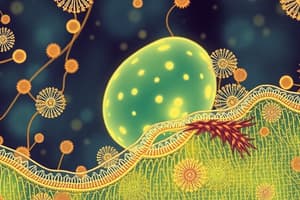Podcast
Questions and Answers
What is the primary role of tight junctions in cellular contexts?
What is the primary role of tight junctions in cellular contexts?
- Enabling signal reception
- Creating impermeable barriers between cells (correct)
- Facilitating cell adhesion
- Transporting molecules across membranes
Which component significantly affects membrane fluidity?
Which component significantly affects membrane fluidity?
- Types of integral proteins
- Concentration of cholesterol
- Length of hydrocarbon tails (correct)
- Amount of water present
What technique uses GFP for studying membrane protein dynamics?
What technique uses GFP for studying membrane protein dynamics?
- SDS-PAGE
- FRAP (correct)
- Electron microscopy
- Western blotting
Which characteristic of a fatty acid is associated with increased membrane fluidity?
Which characteristic of a fatty acid is associated with increased membrane fluidity?
What is a common application of detergents in membrane studies?
What is a common application of detergents in membrane studies?
What model can be used for studying the properties of membranes in controlled environments?
What model can be used for studying the properties of membranes in controlled environments?
Which statement best describes the role of the cell cortex?
Which statement best describes the role of the cell cortex?
What is the function of aggregates in biological membranes?
What is the function of aggregates in biological membranes?
What principle is used to examine the transport functions across the plasma membrane?
What principle is used to examine the transport functions across the plasma membrane?
In the context of membrane structure, what do amphipathic molecules contain?
In the context of membrane structure, what do amphipathic molecules contain?
What is the primary function of cholesterol in the cell membrane?
What is the primary function of cholesterol in the cell membrane?
In which layer of the plasma membrane would you primarily find phosphatidylserine?
In which layer of the plasma membrane would you primarily find phosphatidylserine?
Which lipid is NOT typically found in the outer leaflet of the plasma membrane?
Which lipid is NOT typically found in the outer leaflet of the plasma membrane?
What type of signal do glycolipids on the cell membrane usually help to convert?
What type of signal do glycolipids on the cell membrane usually help to convert?
How does temperature affect membrane dynamics?
How does temperature affect membrane dynamics?
Which type of phospholipid is commonly known for forming cellular membranes?
Which type of phospholipid is commonly known for forming cellular membranes?
What property do the hydrophobic hydrocarbon tails of phospholipids provide to the membrane?
What property do the hydrophobic hydrocarbon tails of phospholipids provide to the membrane?
Which component plays a key role in stabilizing the membrane structure?
Which component plays a key role in stabilizing the membrane structure?
What is the main characteristic of hydrophilic regions in a phospholipid?
What is the main characteristic of hydrophilic regions in a phospholipid?
What type of lipid is primarily involved in cell signaling and recognition?
What type of lipid is primarily involved in cell signaling and recognition?
What is the primary role of membrane asymmetry in cellular function?
What is the primary role of membrane asymmetry in cellular function?
Which type of membrane protein can be classified based on its attachment to the lipid bilayer?
Which type of membrane protein can be classified based on its attachment to the lipid bilayer?
What major component comprises 52% of the membrane's composition?
What major component comprises 52% of the membrane's composition?
In the context of the fluid mosaic model, what characteristic allows phospholipids and proteins to move within the membrane?
In the context of the fluid mosaic model, what characteristic allows phospholipids and proteins to move within the membrane?
Which method is used to observe protein diffusion within cell membranes?
Which method is used to observe protein diffusion within cell membranes?
What role do carbohydrates play in cellular membranes?
What role do carbohydrates play in cellular membranes?
What function do adhesion proteins serve in the membrane structure?
What function do adhesion proteins serve in the membrane structure?
What defines the amphipathic nature of membrane proteins?
What defines the amphipathic nature of membrane proteins?
Which of the following best describes the glycoproteins in the context of the glyocalyx layer?
Which of the following best describes the glycoproteins in the context of the glyocalyx layer?
What is an essential characteristic of transmembrane proteins?
What is an essential characteristic of transmembrane proteins?
Flashcards
Tight junctions
Tight junctions
Specialized cell junctions that hold cells tightly together, preventing leakage between them.
FRAP (Fluorescence Recovery After Photobleaching)
FRAP (Fluorescence Recovery After Photobleaching)
A technique used to measure the mobility of proteins and lipids within a membrane. A small area of the membrane is bleached with a laser, and the recovery of fluorescence is measured over time.
Integral membrane protein
Integral membrane protein
A type of membrane protein that spans the entire lipid bilayer, with portions exposed both inside and outside the cell.
Liposomes
Liposomes
Signup and view all the flashcards
Detergents
Detergents
Signup and view all the flashcards
Fusion protein technique
Fusion protein technique
Signup and view all the flashcards
Degree of saturation
Degree of saturation
Signup and view all the flashcards
Chain length of hydrocarbon tails
Chain length of hydrocarbon tails
Signup and view all the flashcards
Cell cortex
Cell cortex
Signup and view all the flashcards
Protein confinement
Protein confinement
Signup and view all the flashcards
Phospholipids
Phospholipids
Signup and view all the flashcards
Cholesterol
Cholesterol
Signup and view all the flashcards
Outer Leaflet
Outer Leaflet
Signup and view all the flashcards
Inner Leaflet
Inner Leaflet
Signup and view all the flashcards
Bilayer Formation
Bilayer Formation
Signup and view all the flashcards
Membrane Dynamics
Membrane Dynamics
Signup and view all the flashcards
Temperature Effects on Membrane Dynamics
Temperature Effects on Membrane Dynamics
Signup and view all the flashcards
Glycolipids
Glycolipids
Signup and view all the flashcards
Cellular Signaling
Cellular Signaling
Signup and view all the flashcards
Signal Transduction
Signal Transduction
Signup and view all the flashcards
Membrane Fluidity
Membrane Fluidity
Signup and view all the flashcards
Fluid Mosaic Model
Fluid Mosaic Model
Signup and view all the flashcards
Membrane Asymmetry
Membrane Asymmetry
Signup and view all the flashcards
Glycocalyx
Glycocalyx
Signup and view all the flashcards
Transmembrane Proteins
Transmembrane Proteins
Signup and view all the flashcards
Peripheral Membrane Proteins
Peripheral Membrane Proteins
Signup and view all the flashcards
Lateral Diffusion
Lateral Diffusion
Signup and view all the flashcards
Study Notes
Cell Biology: Plasma Membrane Structure
- Plasma Membrane Overview: Separates internal and external environments. Functions include adhesion, force transmission, exchange, signal reception, and cellular recognition.
Membrane Composition
-
Lipids (40%): Main components are phospholipids (phosphatidylethanolamine, phosphatidylcholine, phosphatidylserine, sphingomyelin), cholesterol, and glycolipids. Phospholipids are amphipathic (hydrophilic head, hydrophobic tails), forming a bilayer. Cholesterol stabilizes the membrane. Glycolipids are found on the cell surface.
-
Proteins (52%): Diverse functions (enzymes, transporters, receptors, adhesion proteins). Types include transmembrane, lipid-linked, and peripheral proteins. Integral proteins often span the bilayer.
-
Carbohydrates (8%): Short chains (oligosaccharides) linked to proteins (glycoproteins) or form longer polysaccharide chains (proteoglycans) forming the glycocalyx, important for cell signaling and recognition.
Membrane Structure
-
Fluid Mosaic Model: The membrane is fluid because phospholipids and proteins can move within the plane of the membrane. Movement includes lateral diffusion, rotation, flexion, and rare flip-flop.
-
Lipid Bilayer: A trilaminar structure (two layers of phospholipids with proteins embedded). Hydrophobic tails face inwards, and hydrophilic heads face outwards.
-
Membrane Asymmetry: Inner and outer leaflets of the membrane have different phospholipid compositions.
Membrane Dynamics
-
Fluidity affecting Factors: Temperature, chain length/saturation of fatty acid tails, and cholesterol content affect membrane fluidity.
-
Protein Confinement: Proteins are often confined within the membrane due to interactions with other proteins, lipids, and the cell cortex.
-
Membrane Tools & Methodologies: Techniques like FRAP (Fluorescence Recovery After Photobleaching) and liposomes are used to study membrane dynamics/protein/lipid mobility.
Membrane Protein Organization
- Detergents: Used to isolate membrane proteins from the lipid bilayer
Membrane Functions
- Functional Importance: Membranes are crucial for converting extracellular signals into intracellular ones
Studying That Suits You
Use AI to generate personalized quizzes and flashcards to suit your learning preferences.




